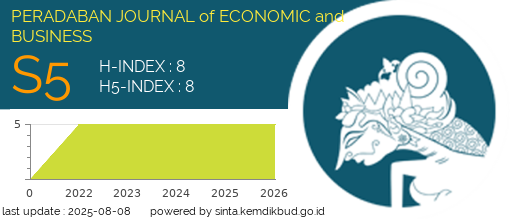Pengaruh Daya Saing Kompetitor dan Determinan Lainnya terhadap Ekspor Kelapa Sawit Indonesia di Tengah Kebijakan Renewable Energy Directive
DOI:
https://doi.org/10.59001/pjeb.v4i2.497Keywords:
daya saing, ekspor, kebijakan perdagangan, kelapa sawit, renewable energy directiveAbstract
As the world’s largest producer and exporter of crude palm oil (CPO), Indonesia has experienced a decline in exports to the European Union since 2016 due to the Renewable Energy Directive (RED) policy and Malaysia’s growing competitiveness. This study aims to analyze the influence of competitor countries’ competitiveness and other determinants on Indonesia’s palm oil export volume to five EU countries (the Netherlands, Germany, Spain, Italy, and Greece). The analysis uses panel data covering the period 2001–2023 with the fixed effect regression method. The findings show that the GDP of destination countries, population, Malaysia’s palm oil competitiveness and productivity, as well as the RED policy, significantly affect export volume. In contrast, the real exchange rate, world palm oil prices, world peanut oil prices, and Indonesia’s palm oil productivity have no significant effect. These results highlight the dominant role of external factors in influencing Indonesia’s CPO exports. The implication is that national strategies should focus on enhancing competitiveness, modernizing agriculture, and strengthening trade diplomacy that adapts to international environmental regulations to ensure long-term export sustainability.
Sebagai produsen dan pengekspor CPO terbesar di dunia, Indonesia mengalami penurunan ekspor ke Uni Eropa sejak 2016 akibat kebijakan Renewable Energy Directive (RED) dan meningkatnya daya saing Malaysia. Penelitian ini bertujuan menganalisis pengaruh daya saing negara pesaing serta faktor determinan lain terhadap volume ekspor minyak kelapa sawit Indonesia ke lima negara Uni Eropa (Belanda, Jerman, Spanyol, Italia, dan Yunani). Analisis menggunakan data panel periode 2001–2023 dengan metode regresi fixed effect. Hasil penelitian menunjukkan bahwa PDB negara tujuan, populasi, daya saing dan produktivitas kelapa sawit Malaysia, serta kebijakan RED berpengaruh signifikan terhadap volume ekspor. Sebaliknya, nilai tukar riil, harga minyak kelapa sawit dunia, harga minyak kacang tanah dunia, dan produktivitas kelapa sawit Indonesia tidak berpengaruh signifikan. Temuan ini menegaskan dominasi faktor eksternal dalam memengaruhi ekspor CPO Indonesia. Implikasinya, strategi nasional perlu diarahkan pada peningkatan daya saing, modernisasi pertanian, dan diplomasi dagang yang adaptif terhadap regulasi lingkungan internasional untuk menjaga keberlanjutan ekspor jangka panjang.
References
Alamsyah, Z., Ratnasari, D., Elwamendri, E., & Fauzia, G. (2024). The influence of EU renewable energy directive policy to Indonesian palm oil exports to some EU countries. IOP Conference Series: Earth and Environmental Science, 1302(1), 012149. https://doi.org/10.1088/1755-1315/1302/1/012149
Amiruddin, A., Suharno, S., Jahroh, S., Novanda, R. R., Tahir, A. G., & Nurdin, M. (2021). Factors affecting the volume of Indonesian CPO exports in international trade. IOP Conference Series: Earth and Environmental Science, 681(1), 012105. https://doi.org/10.1088/1755-1315/681/1/012105
Arnade, C., & Vasavada, U. (1995). Causality between productivity and exports in agriculture: Evidence from Asia and Latin America. Journal of Agricultural Economics, 46(2), 174–186. https://doi.org/10.1111/j.1477-9552.1995.tb00764.x
Badan Pusat Statistik. (2024). Produk domestik bruto Indonesia menurut pengeluaran (2019–2023). Badan Pusat Statistik. http://scioteca.caf.com/bitstream/handle/123456789/1091/RED2017-Eng-8ene.pdf?sequence=12&isAllowed=y
Baiardi, D., & Bianchi, C. (2019). At the roots of China’s striking performance in textile exports: A comparison with its main Asian competitors. China Economic Review, 54, 367–389. https://doi.org/10.1016/j.chieco.2019.02.001
Bilqis, W. N., & Setyari, N. P. W. (2021). Impact of European renewable energy directive (RED) policy on Indonesian palm oil export volume. International Journal of Scientific and Research Publications, 11(3), 317–321. https://doi.org/10.29322/ijsrp.11.03.2021.p11144
Ebadi, A., & Ebadi, A. (2015). How the export volume is affected by determinant factors in a developing country? Research in World Economy, 6(1), 143–152. https://doi.org/10.5430/rwe.v6n1p143
Farrokhi, F., & Pellegrina, H. S. (2023). Trade, technology, and agricultural productivity. Journal of Political Economy, 131(9), 1–25.
Gilani, S. W. (2015). The impact of agricultural imports and exports on agricultural productivity. Journal of Economics and Sustainable Development, 6(11), 109–116. www.iiste.org
Gujarati, D. N. (2003). Basic econometrics (4th ed.). McGraw-Hill.
Hamidi, H. N. A., Khalid, N., & Karim, Z. A. (2024). Palm oil trade restrictiveness index and its impact on world palm oil exports. Agricultural Economics (Czech Republic), 70(3), 101–111. https://doi.org/10.17221/332/2023-AGRICECON
Herniati, & Indrajaya, I. G. B. (2019). Analisis pengaruh daya saing, GDP, inflasi, dan kurs dollar Amerika Serikat terhadap ekspor mutiara Indonesia ke Jepang tahun 2000–2019. E-Jurnal Ekonomi Pembangunan Universitas Udayana, 10(12), 4648–4676. https://ojs.unud.ac.id/index.php/eep/article/view/76332
International Trade Centre. (2025). Trade map. https://www.trademap.org/Index.aspx?nvpm=1
Kementerian Pertanian Republik Indonesia. (2024). Sawit Indonesia dalam dinamika pasar dunia. https://sawitindonesia.com/mengelola-manajemen-afdeling
Krugman, P. R., Obstfeld, M., & Melitz, M. J. (2018). International economics: Theory and policy (11th ed.). Pearson.
Lugo-Arias, E., Lugo-Arias, J., Vargas, S. B., de la Puente Pacheco, M. A., Granados, I. B., Heras, C. B., & Triana Hernández, D. (2024). Determinants of the competitiveness of world palm oil exports: A cointegration analysis. Transnational Corporations Review, 16(3), 1–18. https://doi.org/10.1016/j.tncr.2024.200063
Lymar, M. S., Reentovich, A. A., & Sinyakov, A. A. (2024). A commodity exporting economy under financial and trade restrictions: Aggregate and structural changes. Russian Journal of Economics, 10(2), 103–129. https://doi.org/10.32609/j.ruje.10.127850
Malau, L. R. E., Anjani, R., Ulya, N. A., & Martin, E. (2022). Competitiveness and determinants of Indonesian plywood export. Jurnal Sylva Lestari, 10(2), 278–293. https://doi.org/10.23960/jsl.v10i2.580
Pradina, Y. B. A., & Adhitya, D. (2023). Effect of international CPO prices, substitution goods prices, and exchange rates on crude palm oil (CPO) export volume in Indonesia. Jurnal Ekonomi Pembangunan, 21(1), 1–12. https://doi.org/10.29259/jep.v21i1.19447
Ravi Kumar, K. N., Reddy, K. G., Shafiwu, A. B., & Mohan Reddy, M. J. (2024). Trade determinants and opportunities for Indian rice: A dynamic panel gravity model perspective. Cogent Economics & Finance, 12(1), 2312367. https://doi.org/10.1080/23322039.2024.2312367
Salvatore, D. (2013). International economics (11th ed.). Wiley.
Sanny, L., Polla, J. R., & Fatmawati, I. (2018). The analysis of export potency for Indonesian pepper. Pertanika Journal of Social Sciences and Humanities, 26, 237–246. http://www.pertanika.upm.edu.my/
Soeharjoto, S. (2016). Pengaruh penanaman modal asing dan tingkat daya saing terhadap ekspor industri manufaktur Indonesia. Media Ekonomi, 24(2), 161–174. https://doi.org/10.25105/me.v24i2.3802
Tongeren, F. (2011). The impact of export restrictions on raw materials on trade and global supply. In Globalisation, comparative advantage and the changing dynamics of trade (pp. 317–332). OECD. https://doi.org/10.1787/9789264113084-en
Widyastutik, & Ashiqin, A. Z. (2011). Analisis daya saing dan faktor-faktor yang mempengaruhi ekspor CPO Indonesia ke China, Malaysia, dan Singapura dalam skema ASEAN-China Free Trade Agreement. Jurnal Manajemen & Agribisnis, 8(2), 66–73.
Wulandari, S. A. (2022). Ekspor CPO (crude palm oil) Indonesia ke India dengan analisis model gravity. Jurnal MeA (Media Agribisnis), 7(2), 117–127. https://doi.org/10.33087/mea.v7i2.136
Yemima, R., & Novianti, T. (2020). Competitiveness and determinant of Indonesian processed cocoa demand in the AANZFTA framework. Jurnal Ilmu Ekonomi Terapan, 5(1), 13–25. https://doi.org/10.20473/jiet.v5i1.19627
Yogesh, M., & Mokshapathy, S. (2013). Production and export performance of black pepper. International Journal of Humanities and Social Science Invention, 2(4), 36–44.
Downloads
Published
How to Cite
Issue
Section
License
Copyright (c) 2025 Aftadhea Salvacesa, Eva Ervani

This work is licensed under a Creative Commons Attribution-NonCommercial-ShareAlike 4.0 International License.





